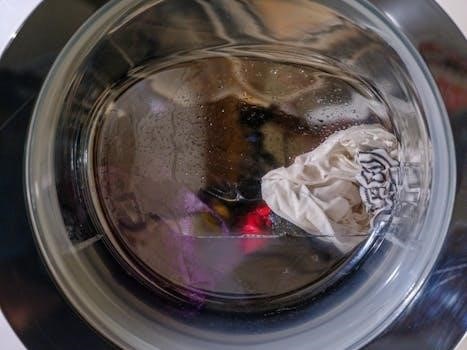The “Dirty Dozen” and “Clean Fifteen” are guides revealing produce pesticide contamination. The Environmental Working Group analyzes USDA data to create these annual lists, helping consumers make informed choices about buying organic versus conventional produce.
Understanding Pesticide Residue in Produce
Pesticide residue refers to the chemicals that remain on fruits and vegetables after they’ve been treated with pesticides. These residues can vary significantly depending on the type of crop, the farming practices used, and the specific pesticides applied. The Environmental Working Group (EWG) tests produce samples and analyzes data from the Department of Agriculture and the Food and Drug Administration to create their lists. Some produce, like those on the “Dirty Dozen,” tends to absorb more pesticides, while others, found on the “Clean Fifteen,” have lower residue levels due to natural protective layers or growing methods. Understanding these differences can help consumers prioritize when to choose organic options.

The Environmental Working Group (EWG) and its Role
The Environmental Working Group (EWG) is a non-profit organization that analyzes pesticide data on produce. They create the Dirty Dozen and Clean Fifteen lists to help consumers.
EWG’s Testing Methodology for Produce
The Environmental Working Group (EWG) analyzes data from the Department of Agriculture and Food and Drug Administration to create the Dirty Dozen and Clean Fifteen lists. This involves examining thousands of samples of various fruits and vegetables. The EWG evaluates the levels of pesticide residue found on each item, determining which produce has the highest and lowest contamination. The analysis includes data from both conventionally grown and organic produce, but it is focused on the residue found in conventional crops. This rigorous approach allows them to provide accurate, annual lists for consumers.

The 2024 Dirty Dozen List
The 2024 Dirty Dozen list highlights twelve fruits and vegetables with the highest pesticide residue levels. These items are recommended to be purchased organic whenever possible to reduce pesticide exposure.
Top 12 Fruits and Vegetables with Highest Pesticide Levels
The 2024 Dirty Dozen includes, but may not be limited to, strawberries, spinach, kale, collard and mustard greens, nectarines, apples, grapes, peaches, pears, cherries, bell peppers, and celery. These fruits and vegetables consistently show high levels of pesticide residues. It’s important to note that some samples of these items may contain as many as 23 pesticides. Consumers should consider purchasing organic versions of these items to minimize their pesticide intake, especially if they are consumed frequently. The list is updated annually based on data from the USDA and FDA.
The 2024 Clean Fifteen List
The Clean Fifteen list features produce with the lowest pesticide residues; This includes avocados, sweet corn, pineapple, onions, and papayas. These items are considered safer to purchase non-organic.
Top 15 Fruits and Vegetables with Lowest Pesticide Levels
The Clean Fifteen list highlights produce with minimal pesticide residue, offering cost-effective options for consumers. Typically, these fruits and vegetables have a thick outer layer that protects the edible parts from pesticide absorption. This year’s list includes items like avocados, sweet corn, and pineapples, often showing very low to no detectable pesticide levels. Other common examples are onions, papayas, and frozen sweet peas. Asparagus, honeydew melon, and kiwi also frequently appear. Furthermore, cabbage, cauliflower, and cantaloupe are often on the list. These selections allow consumers to save money without significant exposure to pesticides.
Year-to-Year Variations in Lists
The Dirty Dozen and Clean Fifteen lists can change annually due to variations in farming practices, pesticide use, and testing data. These shifts influence produce rankings and inclusion from year to year.
Changes in Rankings and Inclusion of Produce
Each year, the Environmental Working Group (EWG) updates its Dirty Dozen and Clean Fifteen lists, reflecting changes in pesticide use and testing results. Produce items can move up or down the rankings, and some may be added or removed entirely. These shifts are influenced by factors like farming practices, weather patterns, and the specific pesticides used on different crops. The lists are based on the latest data from the Department of Agriculture and Food and Drug Administration, making them dynamic and responsive to real-world changes in produce contamination. Therefore, it is important to consult the most recent lists for the most accurate information.
The Significance of Buying Organic
Choosing organic produce, especially from the Dirty Dozen list, minimizes exposure to harmful pesticides. Organic farming practices avoid synthetic pesticides, promoting a healthier food system and protecting consumers.
When to Prioritize Organic Options
Prioritize organic options when purchasing items on the Dirty Dozen list, as these fruits and vegetables typically have the highest pesticide residue levels. If budget constraints exist, focus on buying organic versions of the most contaminated items like strawberries, spinach, and apples. For produce on the Clean Fifteen list, conventional options are usually acceptable due to lower pesticide levels. Consider the health of children and pregnant women, who may be more vulnerable to the effects of pesticide exposure, and for whom organic produce is often a better choice.
Practical Uses of the Lists
These lists guide shopping decisions, helping consumers choose when to buy organic or conventional produce. They prioritize organic purchases for high-pesticide items and allow cost-effective conventional options for low-pesticide ones.
Using the Lists for Informed Shopping Decisions
The Dirty Dozen and Clean Fifteen lists provide a practical way to navigate pesticide exposure in produce. By consulting these lists, shoppers can prioritize purchasing organic options when selecting fruits and vegetables with the highest pesticide residues, as found on the Dirty Dozen list. Conversely, the Clean Fifteen identifies items with the lowest pesticide contamination, where buying conventionally grown produce is a more cost-effective choice. Using these guides allows for informed choices that can reduce pesticide intake while maintaining a healthy diet. This approach is particularly useful for budget-conscious consumers who are still concerned about the presence of pesticides in their food.

Benefits of Consuming Produce from the Clean Fifteen
Choosing produce from the Clean Fifteen list can lower pesticide exposure. This is a cost-effective way to enjoy fruits and vegetables while reducing chemical intake, as these have minimal pesticide residues.
Cost-Effective Options for Reducing Pesticide Exposure
The Clean Fifteen list offers a budget-friendly way to minimize pesticide intake. By prioritizing these fruits and vegetables, consumers can save money without significantly increasing their exposure to harmful chemicals. This approach is especially helpful for those who find organic produce less affordable, allowing them to make healthy choices while managing their grocery expenses. It’s a practical strategy for families seeking to reduce their overall pesticide consumption without overspending on organic options.
Limitations of the Dirty Dozen and Clean Fifteen Lists
These lists offer a helpful guide, but pesticide levels can fluctuate based on farming practices, location and time of year, so these lists are not absolute.
Factors Affecting Pesticide Residue Levels
Pesticide residue levels on produce are influenced by several factors, including the type and amount of pesticides used during farming. The specific growing practices employed by farmers, such as whether they utilize conventional or organic methods, significantly affect residue levels. Geographic location and climate conditions can also affect pesticide levels, as can the time of year when the produce is harvested. Moreover, the way produce is handled post-harvest, including washing and storage, can either reduce or maintain pesticide residues. Lastly, the type of crop and its natural resistance to pests also plays a role.

Additional Tips for Reducing Pesticide Intake
Beyond using the lists, washing produce thoroughly can help reduce pesticide residue. Peeling fruits and vegetables also effectively minimizes exposure. Consider buying local and seasonal produce.
Washing and Peeling Produce Effectively
Washing produce thoroughly is a crucial step in reducing pesticide intake, regardless of whether it’s organic or conventionally grown. Rinsing fruits and vegetables under running water helps to remove surface-level pesticide residues. For produce with thicker skins, using a scrub brush can further enhance cleaning. Additionally, peeling the outer layers of fruits and vegetables can provide an extra layer of protection against residual pesticides. While not all pesticides are removed by washing, these steps significantly minimize your exposure.
Accessing Printable Dirty Dozen and Clean Fifteen Lists
Easily find downloadable versions of the “Dirty Dozen” and “Clean Fifteen” lists online, often in PDF format. These resources are convenient for quick reference while grocery shopping.
Finding and Utilizing Downloadable Resources
Numerous websites, including the Environmental Working Group’s official page, offer printable PDF versions of the “Dirty Dozen” and “Clean Fifteen” lists. These downloadable resources provide a convenient way to access the lists on your phone or in print while grocery shopping. Many sites offer these lists for free, often requiring only an email address for access. Having these lists readily available helps in making informed purchasing decisions, prioritizing organic options for the “Dirty Dozen” and saving money by choosing conventional for the “Clean Fifteen.” These resources are updated annually, making it important to acquire the most recent version.

